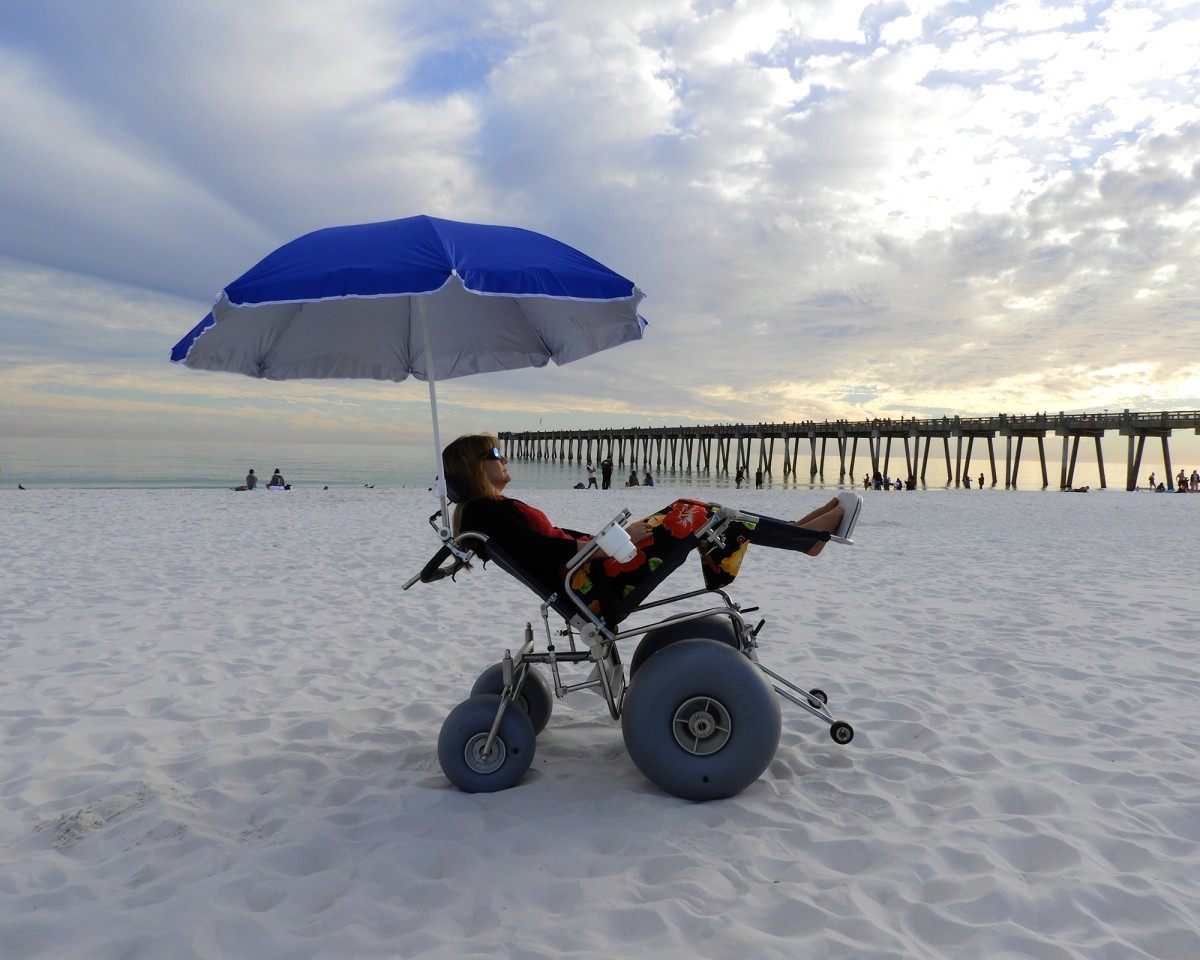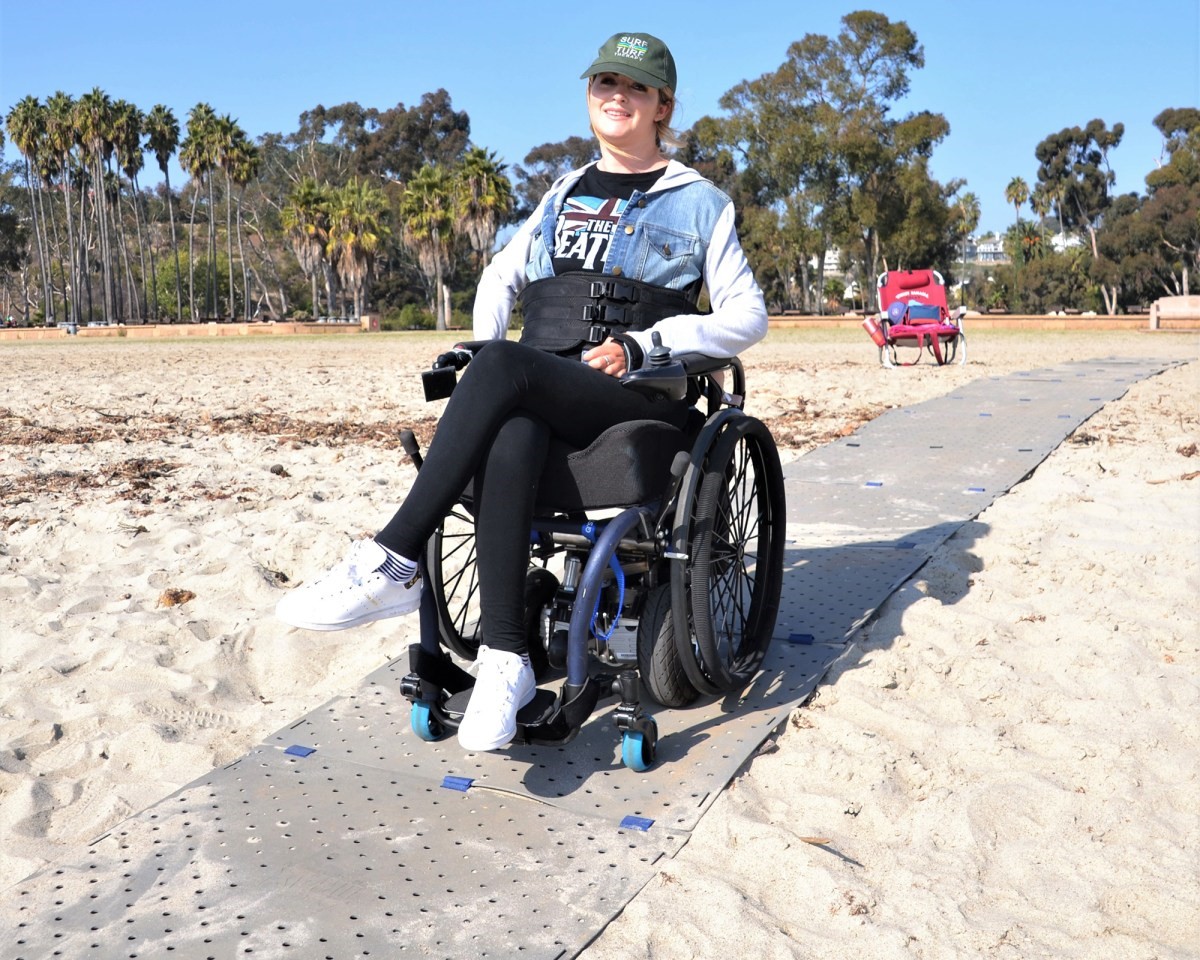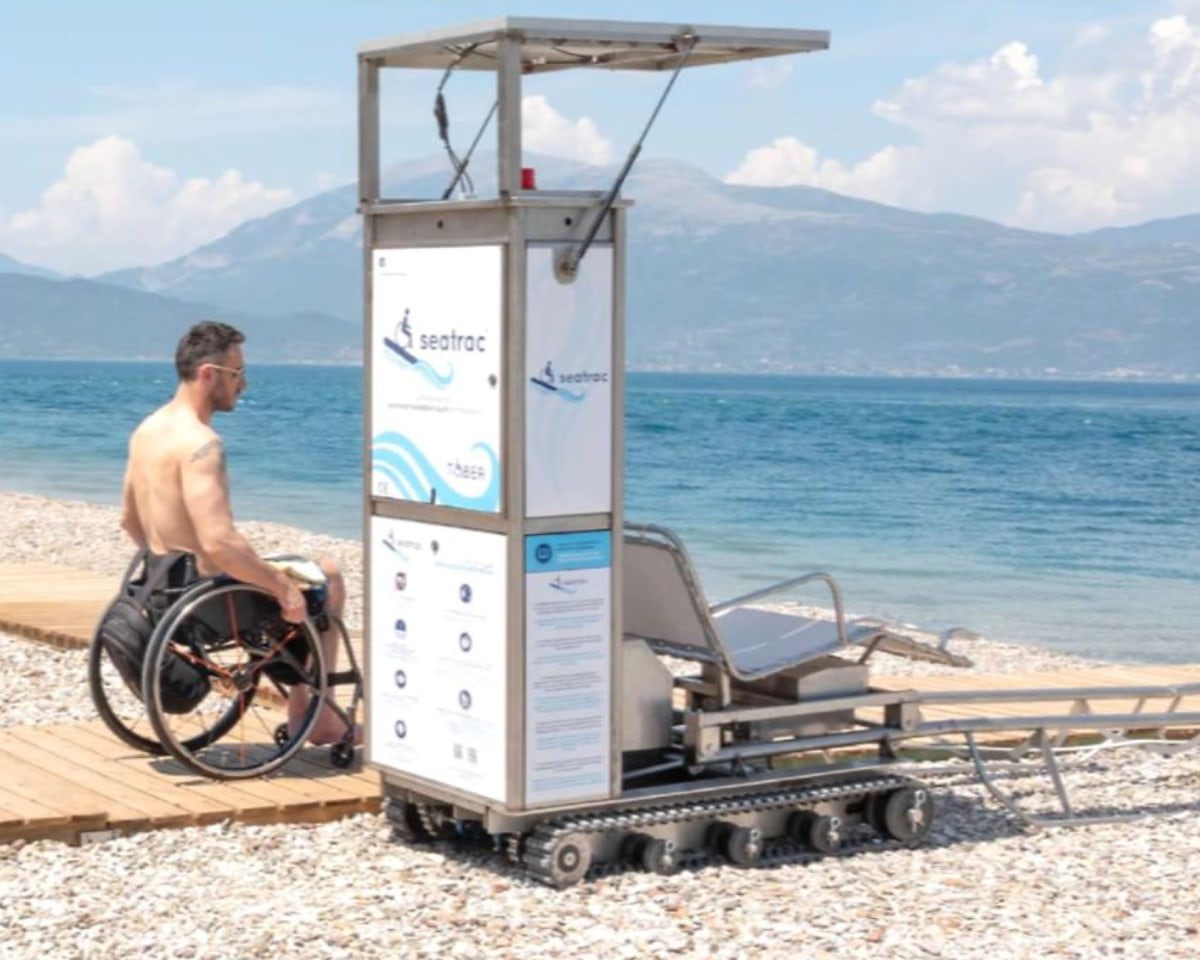A wave of new design innovations is finally making the beach accessible for everyone

Karen Deming was recovering from a car accident when President George H. W. Bush passed the Americans with Disabilities Act in 1990. Just married and 28 years old, Deming loved going to the beach in Pensacola, Florida, where she’d moved for college. But after the accident left her a quadriplegic, she found herself relying on her husband to carry her to the water. “It was so humiliating, I said I would never go back,” she says.
It took a few years, but she did go back—in a special wheelchair her husband Mike Deming designed for her using balloon-like tires that can easily roll on the sand. Today, various companies make beach wheelchairs of the sort, from the French-based Vipamat, to Wheeleez in the U.S. But in the 1990s, Karen found her options were pretty slim.
In 1996, the couple started a company named DeBug Mobility, designing, making, and selling beach wheelchairs. Today, the company sells them to cities, state and federal parks, and private clients like The Ritz, Hilton, Shangri-La, and cruise lines like Royal Caribbean, Disney, and Norwegian. “Accessibility has become not a niche market anymore, but actually a market that is viable all across different segments,” she says.

In many respects, America is a lot more accessible today than it was 30 years ago, largely due to the work of numerous grassroots movements and, of course, the ADA. Curb cuts are now ubiquitous. Buses and trains come with low floors and designated seating areas. And stairs are more often accompanied by ramps (unless you’re Steven Holl, and you’re building a library in Queens).
To comply with ADA requirements, public spaces must provide accessible pathways, entrances, and facilities, but beaches in particular remain a bit of a gray area. Under the ADA, public beaches are mandated to provide equal access for people with disabilities to things such as parking, sidewalks, and bathrooms (when these are provided), but the details can be a little murky. Jennifer Perry, access specialist at the Northeast ADA Center explains: “If you live in a town, and that town happens to have a public beach, the ADA applies to it, so there’s this general obligation not to discriminate against people with disabilities and to provide equal access for people with disabilities, but there is no clear black-and-white standard of ‘here’s what you have to do on a beach to meet that equal access obligation.’”
Those looking for clearer guidelines about providing access on the sand can look to the Architectural Barriers Act (ABA) Outdoor Developed Areas Rule, which includes more specific provisions for beach access routes that are owned or run by federal agencies. But the ABA is only mandatory for federal beaches; and like the ADA, compliance is only enforced through complaints. In other words, a public beach might be inaccessible, and it could stay that way for years, unless someone files a complaint.

The beach accessibility problem
Still, the tides are slowly shifting, both in the U.S. and abroad. It’s impossible to quantify the number of coastlines offering accessible beaches around the world, but various communities are working to promote accessibility and, crucially, provide relevant information to the people who need it most.
In New Jersey, the news company NJ Advance Media recently built a beach accessibility guide that spans 48 towns along the Jersey Shore. In Duval County, Florida, which as of 2020 counted more than 60,000 people with disabilities (or 7.35% of the total population in the country), researchers found that 18.75% of the 112 beaches in the county were accessible.
Both California and Florida have launched apps that let you search for the nearest accessible beach, as has the region of Murcia in Spain. In Australia, nonprofit organization Accessible Beaches Australia has built a directory of disabilities-accessible beaches across the country. Of about 10,000 beaches, 100 are listed as accessible, says Sasha Job, a lecturer in physiotherapy at Australia’s CQUniversity in Bundaberg, Queensland.
Job has been researching accessible beaches for three years now. The number of accessible beaches has more than doubled in that time, but it remains astonishingly low for a country with 16,010 miles of coastline. “The beach is really central to our lifestyle here,” she says.
As part of her research, Job’s team surveyed about 350 people across the Wide Bay region of Queensland. She found that close to 90% of them would visit the beach more often and for longer if accessibility was improved. The most frequently cited barriers were inaccessible ramps and pathways and limited or lacking specialized beach-mobility equipment. After the study, Job developed a conceptual model that reflects how diverse the disabled community is, and how varied what she calls “blue space environments” are, namely outdoor environments with a natural body of water.
The BlueAbility model can be used by researchers, health professionals, community groups, and policy makers anywhere in the world. It outlines the various reasons why a beach could be inaccessible to someone with disabilities, including personal and environmental factors, and suggests various levels of interventions, from providing specialized equipment to ensuring that various features like accessible parking lots are communicated with clear signs because, of course, accessible beaches don’t stop where the sand does. They require accessible parking spots, and restrooms, and changing places.
For Job, a big part of what makes an accessible beach is a wide array of accessible services, like an online booking system for people to reserve the right equipment, or an online calendar of events, like with U-beach, which stands for Universal Beach Access Hub and hosts, among other things, accessible community beach days in Bundaberg.

Designing an accessible beach
But services are only one part of the infrastructure required to make beaches more accessible. The other part, of course, is actually making them more accessible. Perhaps the most ubiquitous accessibility feature to be found in beaches around the world is the Mobi-Mat, which has reigned supreme since it was invented in 1994. But now, a new company out of San Diego wants to give the behemoth a run for its money.
Access Trax makes portable, foldable, modular mats that come in 9-square-foot HDPE modules and are connected by Velcro hinges. Unlike mobility mats, which are big, unwieldy rolls and can only be unrolled in a straight line, Access Trax lets you create an accessible path in any configuration imaginable. And while you could make a T-shaped path by overlapping two mobility mats, these weren’t designed to overlap, which makes them a tripping hazard.
At about five pounds per square, Access Trax mats are also much lighter than a Mobi mat and can fold up like an accordion, so they don’t have to be disconnected every time you put them away. “They store flat, so you can put them in the trunk of a car, and you can also check them as luggage on an airplane,” says Kelly Twichel, an occupational therapist and CEO of Access Trax.
Twichel launched her company in 2018 but didn’t go full steam until she left her job as a full-time clinician in 2020 to focus on her business. The company’s revenue has almost tripled since then, with clients ranging from individual families to nonprofits like Move United and governmental agencies like San Francisco’s Golden Gate Park, which uses Access Trax mats on Chrissy Field and Rodeo Beach.
The problem with mats of any kind, though, is they can only take you so far down the beach. If a person with mobility issues wants to go in the water, options are pretty limited, but Greece may have found a solution.
Over the past decade, Greece has made more than 200 beaches more accessible by installing a free-to-use system called Seatrac, which lets people with disabilities and mobility issues get right into the water. The solar-powered system consists of a fixed track that starts on the beach and ends in the water. A remote-activated chair rolls on that track, so you can slowly, and independently, glide into the water. As Deming from DeBug notes, it only works for people who have mobility in their upper body and are therefore able to hoist themselves up from their own chair and onto the Seatrac chair, but it remains a great option for beaches that want to increase their accessible infrastructure.
Since launching in 2012, Seatrac has expanded to Italy, Cyprus, and Latvia, with plans to expand to other countries like Israel, Turkey, Brazil—and the U.S. A spokesperson told me that SeatracUSA is now the exclusive distributor for Seatrac systems in the Western Hemisphere, and the first system is going to be installed soon in the U.S. Virgin Islands. For now, a map on the company’s website shows all the accessible beaches it covers in Europe, as well as the amenities that are offered in each location.
Back in the U.S., DeBug Mobility has considerably expanded its roster of wheelchairs. The first wheelchair started with a fixed frame and no adjustable leg rest and has since gained an elevated leg rest that can also be adjusted for various leg sizes, plus a headrest for lateral support. The company’s most customizable chair includes a tilt-and-recline mechanism that transforms the wheelchair into a lounge chair. The company also carries beach walkers, beach strollers, and even a surf chair.
Much has changed since Deming’s car accident, and even though there’s plenty more to be done, she says the outlook is different now. “Way back when, for people with disabilities, it was very difficult to travel for a whole host of reasons, so they just didn’t,” she says. “Now, people go on vacation, and they expect that the bathrooms are accessible, that there’s accessible parking, that they can participate in all the activities, that they can get on the beach.”
(24)


